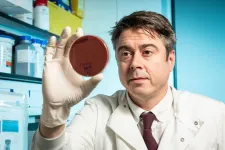(Press-News.org) In Huntington's disease, a faulty protein aggregates in brain cells and eventually kills them. Such protein aggregates could, in principle, be prevented with a heat shock protein. However, it is not well known how these proteins interact with the Huntington's disease protein. New research by Patrick van der Wel (University of Groningen, the Netherlands) and colleagues at the University of Texas has partially resolved the structure of heat shock proteins that bind to such aggregating proteins, helping us to understand how they work. The results were published on 11 February in the journal Nature Communications.
Heat shock proteins (Hsp) are produced by cells that are exposed to stressful conditions. The Hsp family is diverse, and quite a few of the proteins function as chaperone. This means that they help other proteins to fold (or re-fold after being damaged) in the correct way. "These proteins can assist in folding thousands of different proteins. To this end, they use co-chaperones with specific binding abilities," explains Patrick van der Wel, Associate Professor of Solid-State NMR Spectroscopy at the University of Groningen.
Ordered
One class of heat shock proteins, Hsp40, helps to suppress protein aggregates like those that appear in Huntington's disease. These Hsp40 proteins come in different kinds, and some of them will bind specifically to aggregating proteins with a lot of repeated glutamine amino acids, like the faulty protein found in Huntington's disease. One of these Hsp40 proteins is called DnaJB8, and this was the protein studied by Van der Wel and his colleagues.
"In order to understand the action of DnaJB8, we need to know what it looks like," says Van der Wel. However, it is difficult to resolve the structure of this type of protein. "It appears as a dimer or an oligomer, so a number of these protein units work together, but their structure is not really ordered," he continues. This makes it impossible to use standard techniques, which all require ordered structures.
Carbon atoms
Van der Wel was asked by colleagues at the University of Texas to help tackle this problem. Van der Wel is specialized in solid-state NMR spectroscopy, a technology that can measure how atoms are connected to each other. In simple terms, the NMR signals of two connected carbon atoms in DnaJB8 depend on how they interact with other atoms in the molecule. Therefore, the measured spectrum of the carbon atoms can show in which amino acid they are located. Such information can be used to get an idea of the protein's structure, even if it is not well ordered.
The DnaJB8 protein is made up of different domains, with different functions. Through a series of experiments, Van der Wel was able to determine which domains are stuck inside the DnaJB8 protein, and which are available on the outside. The experiments suggested that the so-called 'J domain' of DnaJB8 was able to switch between being stuck and being accessible. This is important because this part of the DnaJB8 protein is responsible for turning on the Hsp70 protein, which can prevent the protein aggregates from forming. In other words, there seems to be a 'switch' in DnaJB8 that controls this interaction with Hsp70. Interestingly, this switch was found to be located in a domain of DnaJB8 whose exact role was previously unclear.
Hypothesis
"Thus, our hypothesis based on the structure was that the DnaJB8 is inactive until it binds to the faulty proteins and that it then attracts Hsp70," says Van der Wel. A series of simulations and experiments at the University of Texas confirmed this idea and yielded a detailed model of how these proteins work together.
DnaJB8 is a protein that is mainly found in the testes. However, a very similar protein called DnaJB6 is present in the brain, where Huntington's disease strikes. It seems more than likely that this protein acts similarly, when it protects against glutamine-rich proteins that aggregate in the brain cells of patients. "It may take many more years, but now that we understand how this process works, it could help us to find a way to enhance the activity of DnaJB6, which could reduce the protein aggregates that cause the disease," concludes Van der Wel.
INFORMATION:
Simple Science Summary
Our cells have specialized waste disposal systems to keep our body free from clumps of defective proteins. To fight diseases like Huntington's, where protein clumps damage and ultimately kill brain cells, it is necessary to know how these disposal systems - which are themselves made up of proteins - work. Scientists studied a disposal system that protects against clumps like those in Huntington's disease. As these disposal proteins themselves also form 'good' clumps, it was difficult to discover their exact structure. Using special techniques, the scientists discovered that, under normal circumstances, two regions of these proteins are folded onto themselves. However, when they encounter the clumps, these two parts release each other and are then free to attach to another protein that dissolves the clumps. In the distant future, this insight may lead to drugs that stimulate the prevention of these harmful protein clumps.
Reference: Bryan D. Ryder, Irina Matlahov, Sofia Bali, Jaime Vaquer-Alicea, Patrick C. A. van der Wel, & Lukasz A. Joachimiak: Regulatory inter-domain interactions influence Hsp70 recruitment to the DnaJB8 chaperone. Nature Communications, 11 February 2021
A new study has identified early risk factors that predicted heightened anxiety in young adults during the coronavirus (COVID-19) pandemic. The findings from the study, supported by the National Institutes of Health and published in the Journal of the American Academy of Child and Adolescent Psychiatry, could help predict who is at greatest risk of developing anxiety during stressful life events in early adulthood and inform prevention and intervention efforts.
The investigators examined data from 291 participants who had been followed from toddlerhood to young adulthood as part of a larger study on temperament and socioemotional development. The researchers ...
Osteoporosis is a leading global health challenge. Besides its own adverse effects, it also impairs the function of bone implants - normally made of a metal called titanium (Ti). Because there is less bone than normal in the implantation site, the implants could easily loosen, and persistent inflammation often accompanies.
Recently, Chinese scientists from the University of Macau and Nanjing University, in collaboration with National Dental Centre Singapore, invent a bioactive coating that can be chemically linked onto normal Ti surface. This coating, ...
WHAT:
The rise of several significant variants of SARS-CoV-2, the virus that causes COVID-19, has attracted the attention of health and science experts worldwide. In an editorial published in JAMA: The Journal of the American Medical Association, experts from the National Institute of Allergy and Infectious Diseases (NIAID), part of the National Institutes of Health, outline how these variants have arisen, concerns about whether vaccines currently authorized for use will continue to protect against new variants, and the need for a global approach to fighting SARS-CoV-2 as it spreads and acquires additional mutations.
The article was written by NIAID Director Anthony S. Fauci, M.D.; John R. Mascola, ...
How much does a power system's reliability depend on the temperature? Electric power system generator resource adequacy modeling is designed to help determine capacity requirements for electric power system operators across the United States. While calculating resource adequacy requirements has been done for a century, it requires ongoing attention as the generation mix is constantly expanding and changing. A new paper contributes to these ongoing reliability considerations by using a unique data set to determine how both low and high temperatures reduce the reliability of coal, gas, diesel, hydroelectric, and nuclear power generators and thus affect the amount of generation markets should contract for.
The paper, "Resource Adequacy Implications ...
In a courtesy call to HE the President of Malta at San Anton Palace on Thursday, February 11, 2021, Dr Noel Aquilina from the Department of Chemistry, accompanied by Professor Emmanuel Sinagra, Head of the Department of Chemistry and Dean of the Faculty of Science at the University of Malta, presented the findings of a landmark study. This study shows and confirms that airborne particulate matter (PM), apart from several toxic components, is also contaminated with tobacco smoke-driven particulates.
After 30 years, Dr Noel Aquilina, alongside world renowned tobacco smoke-related researchers, ...
The Internet has revolutionized our lives - whether in terms of working, finding information or entertainment, connecting with others, or shopping. The online world has made many things easier and opened up previously unimaginable opportunities. At the same time, it presents both individuals and societies with major challenges: The underlying technologies do not necessarily serve users' best interests.
"We're interested in questions such as: How can we create online environments that respect human autonomy and promote truth? And what can people themselves do to avoid being ...
An international team of scientists has determined how harmless E. coli gut bacteria in chickens can easily pick up the genes required to evolve to cause a life-threatening infection. Their study, published in Nature Communications, warns that such infections not only affect the poultry industry but could also potentially cross over to infect humans.
E. coli is a common bacterium that lives in the intestines of most animals, including humans. It is usually harmless when it stays in the gut, however it can become very dangerous if it invades the bloodstream, causing ...
"We are surrounded by a huge number of systems - biological, technical, economic, which we can influence, which we can control. The task is to do it optimally, for example, reaching the desired point with a minimum of effort, resources, and time, - explains Prof. Yurii Averboukh. - From a mathematical point of view, the task is narrowed down to the theory of optimal control. A classic example of this theory is moon landing: fuel consumption optimization enables to increase cargo volumes transported to the moon".
A special section of optimal control theory is the theory of differential games. It studies the control ...
Sophia Antipolis, 12 February 2021: An active lifestyle is linked with a lower chance of dying immediately from a heart attack, according to a study published today in the European Journal of Preventive Cardiology, a journal of the European Society of Cardiology (ESC).1
Heart disease is the leading cause of death globally and prevention is a major public health priority. The beneficial impact of physical activity in stopping heart disease and sudden death on a population level is well documented. This study focused on the effect of an active versus sedentary lifestyle on the immediate course of a heart attack - an area with ...
A study has now been presented that boosts the evidence for using AI solutions in skin cancer diagnostics. With an algorithm they devised themselves, scientists at the University of Gothenburg show the capacity of technology to perform at the same level as dermatologists in assessing the severity of skin melanoma.
The study, published in the Journal of the American Academy of Dermatology, and its results are the work of a research group at the Department of Dermatology and Venereology at Sahlgrenska Academy, University of Gothenburg.
The study was conducted at Sahlgrenska University ...





